| Web
and Book design,
Copyright, Kellscraft Studio 1999-2010 (Return to Web Text-ures) |
Click
Here to return to
Japanese Homes and their Surroundings Content Page Return to the Previous Chapter |
 (HOME)
|
|
CHAPTER IV.
INTERIORS (Continued). KITCHEN.
FLOORS. CLOSETS. STAIRWAYS. PUBLIC BATHING.
BATHING CONVENIENCES. TOWEL-RACKS. BEDDING AND PILLOWS.
HIBACHI AND TABAKO-BON. CANDLES AND CANDLESTICKS. LAMPS AND
LANTERNS. HOUSEHOLD SHRINES. BIRDS' NESTS IN HOUSES.
PRIVIES.
THE kitchen, as an apartment, varies quite as much in Japan as it does in our country, and varies in the same way; that is to say, in the country, in houses of the better class, both in Japan and the United States, the kitchen is large and oftentimes spacious, well lighted and airy, in which not only the preparation of food and the washing of dishes go on, but in which also the meals are served. The kitchen of the common city house in both countries is oftentimes a dark narrow room, ill-lighted, and altogether devoid of comfort for the cook. Among this class of houses the kitchen is the least defined of Japanese rooms; it lacks that tidiness and definition so characteristic of the other rooms. It is often a narrow porch or shed with pent roof, rarely, if ever, possessing a ceiling; its exposed rafters are blackened by the smoke, which finds egress through a scuttle, through which often comes the only light that illuminates the dim interior. In the city house the kitchen often comes on that side of the house next the street, for the reason that the garden being in the rear of the house the best rooms face that area; being on the street too, the kitchen is convenient for the vender of fish and vegetables, and for all the kitchen traffic, which too often with us results in the strewing of our little grass-plots with the wrapping paper of the butcher's bundles and other pleasing reminiscences of the day's dinner. In the country the kitchen is generally at the end of the house usually opening into some porch-like expansion, where the tubs, buckets, etc., and the winter's supply of wood finds convenient storage. 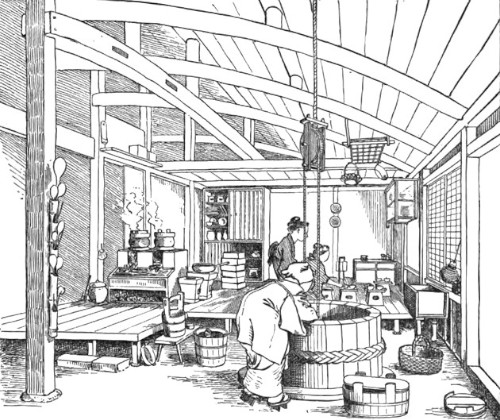 167. KITCHEN IN OLD FARMHOUSE AT KABUTOYAMA In public inns and large country houses, and also in many of the larger city tea-houses, the customary raised floor is divided by a narrow area, which has for its floor the hard trodden earth; and this area forms an avenue from the road to the heart of the house, and even through the house to the garden beyond. This enables one to pass to the centre of the house without the necessity of removing one's shoes. Porters and servants bring the guest's baggage and deposit it directly upon the mats; and in the inns more privacy is secured by the kago being brought to the centre of the house, where the visitor may alight at the threshold of the very room he is to occupy. A plank or other adjustable platform is used to bridge this avenue, so that occupants may go from one portion of the house to another in their bare or stockinged feet. 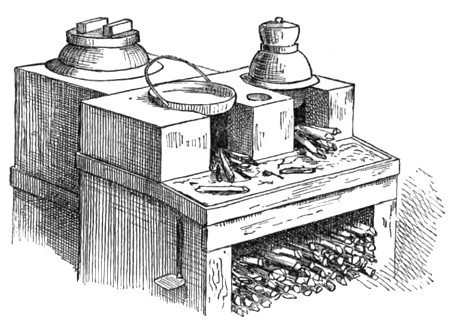 168. KITCHEN RANGE If this area is in a public inn, the office, common room, and kitchen border one side of this thoroughfare. In the common room the baby-tending, sewing, and the various duties of the family go on under the heavily-raftered and thatched roof, which blackened by the smoke from the kitchen fire, and festooned with equally blackened cobwebs, presents a weird appearance when lighted up by the ruddy glow from the hearth. We speak now of the northern country houses, particularly where the fireplace, as in the Aino house, is in the middle of the floor. In country houses of the better class the kitchen is large and roomy; the well is always conveniently near, and often under the same roof. An enormous quantity of water is used in the kitchen of a Japanese house; and if the well is outside, then a trough is arranged beside the well, into which the water is poured, and from this trough a bamboo spout conveys the water into a big water-tank within the kitchen. In the vicinity of the well it is always wet and sloppy; the vegetables, rice, dishes, and nearly every utensil and article of food seem to come under this deluge of water. Fig. 167 (page 186) gives a sketch of an old kitchen at Kabutoyama in the western part of the province of Musashi. This kitchen is nearly three hundred years old, and is the type of a kitchen of a wealthy and independent Japanese farmer. The great wooden curbed well is seen in front, with a pulley above in which the rope runs. Near by is a trough from which a bamboo spout leads to some trough in another portion of the house. The kamado, or cooking-range, is seen to the left, and beyond is a room partly closed by fusuma. Directly beyond the well two girls may be seen in the act of preparing dinner, which consists in arranging the dishes on little raised lacquered trays, which are to be carried in when dinner is ready. Near the range are little portable affairs made of soft stone and used as braziers. The raised floor is composed of broad planks; kitchens invariably have wooden floors, which are oftentimes very smooth and polished. The usual form of kitchen range is represented in fig. 168; this is made of broken tiles and mud or clay compacted together and neatly plastered and blackened on the outside. In this range there are two recesses for fire, which open directly in front; and this structure rests upon a stout wooden frame having a place for ashes in front, and a space beneath in which the wood and charcoal are kept. Sometimes this range, retaining the same form, is made of copper; within this water is kept, and little openings permit the wine-bottle to be immersed in order to heat it, as the sake is drunk hot without the admixture of hot water. In another kitchen in a house in Imado, Tokio, a hood of sheet-iron was arranged to convey the smoke outside the building. This is probably a modern device (fig. 169). In fig. 170 a sketch is given of a kitchen in Tokio in which the range was a closed affair made of stone, with a funnel at the end as in our stoves. I was told by the owner of this house that this kind of a stove had been in use in his family for three generations. at least. In this kitchen an area level with the ground is seen, in which stands the sink containing an inverted rice-kettle. Beside the sink stands a huge water-jar, with water-bucket and water-dipper conveniently near ; above is a shelf upon which are numerous buckets and tubs. On one of the posts hangs the usual bamboo rack for skewers, wooden spoons, spatulas, etc., and below it is a case for the meat and fish knives. On a bamboo pole a few towels hang, and also two large fishes' heads from which a thin soup is to be made. On a post near the mouth of the stove hangs a coarse wire sieve with which to sift the ashes for the little bits of unburnt charcoal, which are always frugally saved, and near by is a covered vessel to hold these cinders. The customary stone brazier for heating water for the tea stands near the stove. 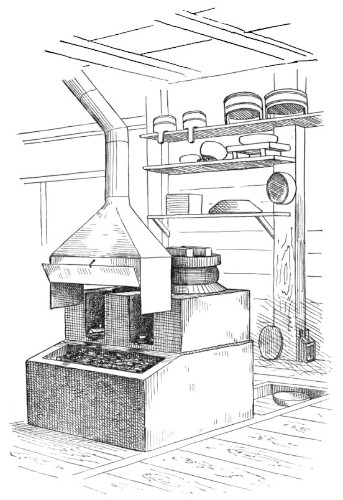 169. KITCHEN RANGE WITH SMOKE-CONDUCTOR Fig. 171 represents more clearly the form of this brazier, which is called a shichirin. It is a convenient and economical device for the cooking of small messes or for boiling water, charcoal being used for the purpose. Instead of bellows, a fan is used for kindling or quickening a fire. A short bamboo tube is also used through which the cook's lungs act as a bellows in performing a like service. Fig. 172 gives a clearer view of the bamboo rack and the knife-case below, with which almost every kitchen is supplied. Often in public inns the kitchen opens on the street, where the cook may be seen conspicuously at work. In our country the chop-houses oftentimes have the grilling and stewing ostentatiously displayed in the same way, as an appetizing inducement to attract guests. 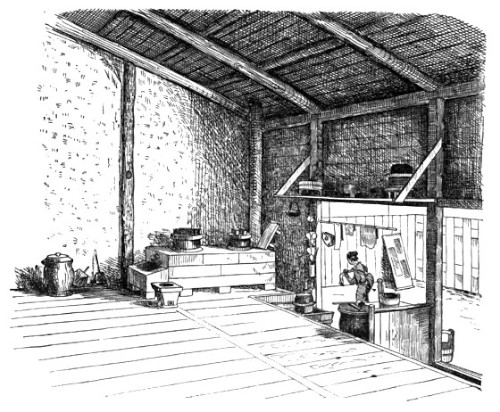 170. KITCHEN IN CITY HOUSE 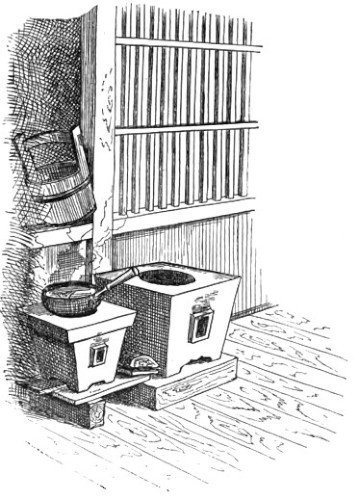 171. BRAZIERS Fig. 174 gives a view of a common arrangement for the kitchen in the north of Japan, and in the country everywhere. Here the fireplace is in the centre of the room. A kettle is suspended over the fire by a chain, and other kettles are huddled around it to be heated. Overhead a rack hangs, from which fish and meat are suspended, and thus the smoke which ascends from the fire is utilized in curing them. Sometimes a large cushion of straw is suspended above the smoke, and little fish skewered with pointed sticks are thrust into this bunch of straw like pins in a pin-cushion.   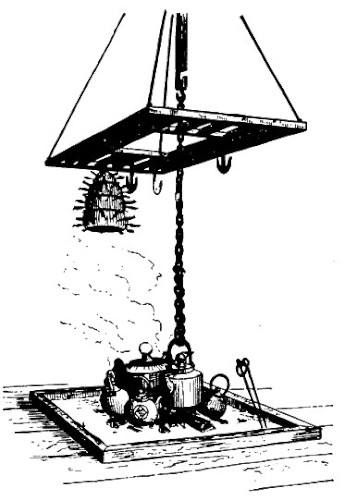
172.
BAMBOO RACK
173. JI-ZAI
174.
FIREPLACE IN COUNTRY
HOUSE
AND
KNIFE-CASE
In fig. 175 a more elaborate affair is shown from which to suspend the teakettle. This is a complex mechanism with a curious joint, so that it may be hoisted or lowered at will. 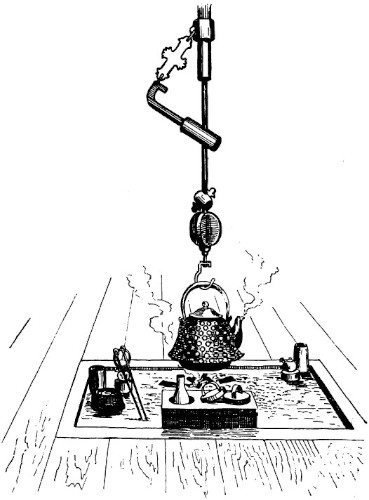 175. THE BEST FIREPLACE In the hut of the peasant a simple affair is seen (fig. 173) made out of bamboo, which answers the same purpose. This is called a ji-zai, which means "at one's will." In the front of fig. 175 a square copper box is noticed, having two round openings. This box is filled with water, which becomes heated by the fire, and is for the purpose of warming the sake, or wine. The tongs are stuck into the ashes in one corner. 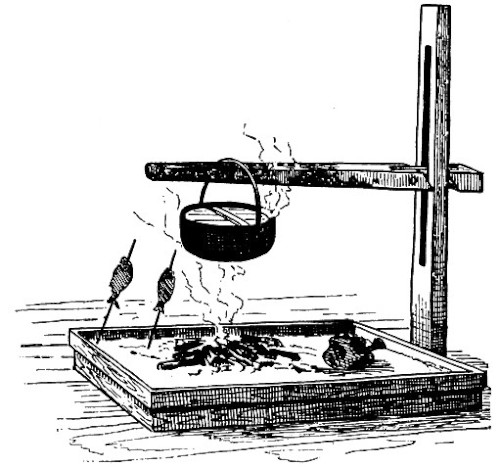 176. AN ADJUSTABLE DEVICE FOR SUPPORTING A KETTLE These consist of a long pair of iron chop-sticks held together at one end by a large ring, so that one leg of the tongs, so to speak, may not get misplaced. No inconsiderable skill is required to pick up hot coals with this kitchen implement, as in unaccustomed or awkward hands the ring prevents the points from coming together. It may be proper to mention here an arrangement for holding a pot over the fire, seen in a boat coming down the Kitakami River, and which is probably used in the north of Japan, though I have never seen it in the house. It consisted of an upright stick having a groove through the centre. In this groove fitted a jointed stick resting horizontally, and arranged in such a way that it could be adjusted at any height. Fig. 176 (page 195) will illustrate the manner of its working better than any description can.
The floor of most rooms, being permanently covered with the mats already described in previous chapters, has no special attention bestowed upon it; at all events, the floor is often of rough boards laid in such a way that irregular spaces occur between them. When the house has a proper hall or vestibule, the floor is composed of wide planks; and the smooth, ivory-like, polished condition in which such floors are often kept is surprising In country houses it is not unusual to see polished-wood floors in portions of the front rooms, and as one rides along the road he may often see the reflection of the garden beyond In their polished surfaces. In country inns the floor in the front of the house is often of plank. Matted floors are, however, universal from the extreme north to the extreme south of the Empire. In houses of traders bordering the street the matted floor properly terminates a few feet within the sill, the space between being of earth. The floor being raised, the space between the edge of the floor and the earth is generally filled with plain panels of wood, though sometimes designs of flowers or conventional figures are cut in the panel. These panels are often arranged so that they can be removed, revealing a space under the floor in which shoes, umbrellas, etc., can be stowed away. One of the surprising features that strike a foreigner as he becomes acquainted with the Japanese house is the entire absence of so many things that with us clutter the closets, or make squirrel-nests of the attic, I speak now of the common house. The reason of this is that the people have never developed the miserly spirit of hoarding truck and rubbish with the idea that some day it may come into use: this spirit when developed into a mania converts a man's attic and shed into a junk shop. The few necessary articles kept by the Japanese are stowed away in boxes, cupboards, or interspaces beneath the floors. The kitchens in every case have wood floors, as do the halls, verandahs, and all passage-ways. The ground beneath the floor is, in the houses of the better class, prepared with gravel and mortar mixed with clay, or macadamized. 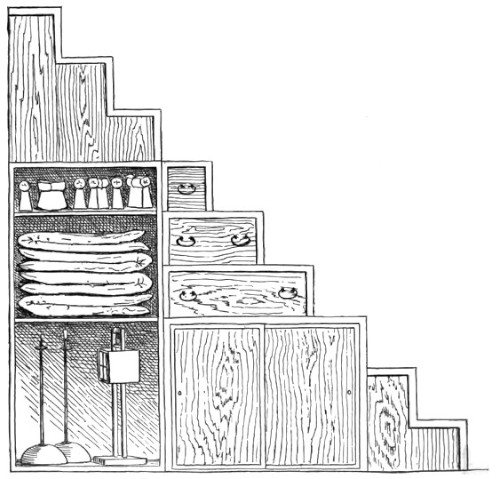 177. KITCHEN CLOSET, DRAWERS, CUPBOARD, AND STAIRS COMBINED A variety of closets is found in the Japanese house. The larger closets, closed by sliding screens, or fusuma, are used for clothing and bedding. The tansu a chest of drawers not unlike our bureau is often placed within the closet, which is also a receptacle for chests and trunks. The ordinary high closet is not so often seen; and where in our houses it is deemed a necessity to have each chamber provided with a closet, in the Japanese house bed-chambers rarely contain such conveniences. There are low cupboards or closets in certain recesses, the upper part or top of which forms a deep open shelf. In the kitchen, dressers and similar conveniences are used for the dishes. In the province of Omi it is common to see a case of shelves with cupboard beneath; upon the shelves the larger dishes are displayed. In the kitchen there is often combined with the flight of stairs a closet; and this closet usually has a door swinging on hinges. In this closet are often kept the bed-clothes, pillows, candle-sticks, and night-lamps. Fig. 177 illustrates the appearance of this closet. In the hallway, also, a closet is sometimes seen in which to stow away the geta, or wooden clogs. A closet of this nature is described farther on.
As most of the houses are of one story, and the area between the ceiling and the roof never utilized, as with us, stairways are not common; when they do occur they are primitive in their construction. A stairway incorporated into the structure of a building and closed below I have never seen in Japan; nor is there any approach to the broad, low steps and landings or spiral staircases such as we are familiar with in American houses. If the house be of two stories the staircase assumes the form of a rather precipitous step-ladder; that is, it has two side-pieces, or strings, in which the steps, consisting of thick plank, are mortised. This ladder is so steeply inclined that one has to step sideways in ascending, otherwise his knee would strike the step above. Rarely is there any convenience to hold on by: if present, however, this consists of a strip of wood fastened to the wall, or a rope is secured in the same way. The front of the step is open, that is, there is no riser; but if the back of the steps face an open room, then slats of wood are nailed on behind. In a beautiful house recently erected in one of the imperial gardens is a remarkably pure and simple staircase and rail (fig. 178). 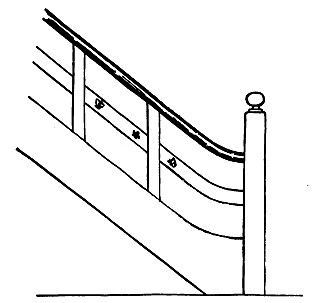 178. STAIR-RAIL In the inns and large farm-houses the step-ladder form is often seen, and this is removable if occasion calls for it. Another kind, common to the same class of houses, has the appearance of a number of square boxes piled one upon another, like a set of different-sized blocks. This is a compact structure, however, though in reality consisting of a number of compartments which may be separated. There are many forms of this kind of staircase. The one shown in fig. 177 has the first two steps closed; then comes a low cupboard with sliding doors at the side, its upper corner forming another step. Upon the cupboard rest three more steps, each of which has a drawer which pulls out at the side. Next to this comes a high closet, supporting on its top two or three more steps. This closet usually has a swinging door, a feature rarely seen elsewhere within the Japanese house proper. This closet contains on its floor the night-lamp, or andon, and tall candlesticks, and above are stowed away the bedding and pillows; or it may be used for trays and dishes. The steps are not so steep as in the ladder form, have no baluster or rail, and are remarkably solid. It may be well to say here that the wood composing the staircase, as well as certain floors, is highly finished, often with a surface like polished ivory. I have frequently examined the wood for evidences of wax or polish applied to its surface, but found none. Inquiry brought out the curious information that the water from the bath is often used to moisten the cloth with which the wood is wiped; and evidently the sebaceous secretions of the skin had much to do with the beautiful polish often attained. When a house possesses a genka, or hall, the steps, two or three in number, are as broad as the hall, and generally the steps are somewhat higher than our steps. These steps are in every case permanently built into the structure of the floor. In the steps which lead from the verandah to the ground the usual form is in the shape of square or irregular blocks of stone or wood; if of wood, the step may be a transverse section of some huge tree, or a massive plank. Other forms of steps may consist simply of two side-pieces, with the steps made of plank and mortised in (fig. 179); or a more compact structure may be made with a very low hand-rail. These forms are all adjustable; that is, they may be placed at any part of the verandah. 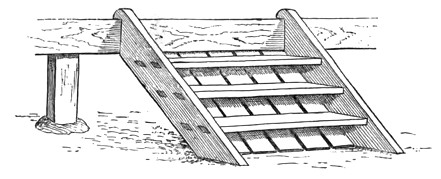 179. STEPS TO VERANDAH
There is no feature of social life in Japan which has been more ignorantly, and in some cases wilfully, animadverted upon than the custom of public bathing; nevertheless, I dare to say that there is no feature in Japanese life to be more heartily commended than this same system of public bathing. But by this assertion I do not mean to suggest that we shall forthwith proceed to establish baths after the Japanese style, and take them after the Japanese fashion. The Japanese, as well as other Eastern people, have for centuries been accustomed to see nakedness, without its provoking among them the slightest attention, or in any way suggesting immodesty. With us, on the contrary, the effect has been different; and the dire result is seen in the almost utter extinction in our country of the classical drama, and the substitution therefor of ballet-dancing and burlesques, of anything in fact that shall present to the vulgar gaze of thousands the female form in scanty apparel.1 A Turkish woman looks upon her Christian sister as not only immodest and vulgar, but absolutely immoral, because she unblushingly parades the public street with a naked face; but the Christian woman knows that the established customs of her country sanction such an exposure as entirely proper. A girl who in our country would deem it immodest to appear among the members of her own family in a robe de chambre, and yet under the glare of a bright gas-light, in the midst of scores of strangers, appears with low corsage, is committing an act which to a Turkish woman would appear inexplicable. To a Japanese, the sight of our dazzling ball-rooms, with girls in dιcolletι dresses, clasped in the arms of their partners and whirling to the sound of exciting music, must seem the wildest debauch imaginable; for in Japan the sexes, except among the lower classes, never intermingle. No free and happy picnics, sleigh-rides, boat-sails, and evening parties among the girls and boys are known there; no hand-shake, no friendly kiss. If the Japanese visitor in this country is a narrow-minded and witless scribbler, he will probably startle his friends at home with accounts of the grossly immoral character of Christians. Unfamiliar as he is with the corner loafer eying every girl that walks by, or with that class which throng our walks with the sole purpose of staring at the girls, who are there for the purpose of being stared at, what must he think of our people when he visits our summer resorts at the seaside and sees a young girl nay, swarms of them tripping over the sand under a bright sun, bare-legged, clad only in a single wrapper, which when wet clings to her form and renders her an object of contemplation to a battalion of young men who fringe the beach! In Japan, among the lower classes, the sexes bathe together, but with a modesty and propriety that are inconceivable to a foreigner until he has witnessed it. Though naked, there is no indecent exposure of the person. While in the bath they are absorbed in their work, and though chatting and laughing seem utterly unmindful of each other. The grossest libels have been written about the Japanese in reference to their custom of public bathing; and I hazard the statement, without fear of contradiction, that an intelligent Japanese, seeing many of our customs for the first time, without knowing the conditions under which they had grown up, would find infinitely more to condemn as immodest, than an intelligent foreigner would find in seeing for the first time certain Japanese customs, with the same ignorance at the outset as to what such customs implied. If cleanliness is next to godliness, then verily the Japanese are a godly race.2 The simple statement, without qualification, that numbers of Japanese in their public baths bathe in the same water would seem a filthy habit. Certainly if such a statement were really true in regard to our own lower classes, it would be a most filthy habit. When it is understood, however, that the Japanese working classes such as the carpenters, masons, and others often bathe two or three times a day, and must of necessity enter the bath in a state of cleanliness such as our workmen rarely if ever attain, the statement loses some of its force. When it is further added that these people do not wash in the baths, but boil or soak in them for a while, and then upon a platform, with an extra bucket of water and a towel, wash and dry themselves, the filthy character of this performance assumes quite another aspect. A Japanese familiar with his airy and barn-like theatres, his public readings under an open tent-like structure, or gatherings in a room in which one or all sides may be open to the air even in mid-winter, would look upon the usual public gatherings of our people in lecture-halls, schoolrooms, and other closed apartments, wherein the air often becomes so foul that people faint and struggle to the door to get a breath of fresh air, a Japanese, I say, would justly look upon such practices as filthy to the last degree. And what would he say to one of our great political meetings, for example, where a vast unwashed herd of perspiring and excited people actually bathe their delicate membranous lungs in the combined breath of hundreds! The public baths, however, do not concern us, though it may be well to contrast our country with Japan in this respect, where in the latter country every village and every town, and in the city nearly every square, possess public baths where for the price of a cent or two one may find conveniences for a hot bath; while in our country public baths are only found in the larger cities, and few of these even can boast of such a luxury. As for the private houses in our country where bathing is customary, an inquiry shows that few possess the convenience of a bath-tub. 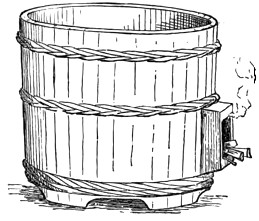 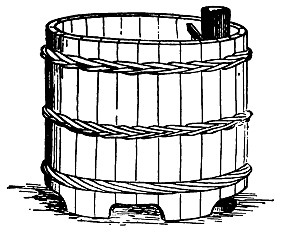 180. BATH-TUB, WITH SIDE OVEN 181. BATH-TUB, WITH INSIDE FLUE Among the masses of our people a Saturday-night wash may or may not be enforced; when it is, this performance usually takes place in the kitchen, with hot water furnished from the kettle. But in Japan nearly every house among the higher and middle classes possesses the most ample arrangements for hot baths; and even among the poorer classes, in the country as well as in the city, this convenience is not wanting, with the added convenience of public baths everywhere attainable if desired.
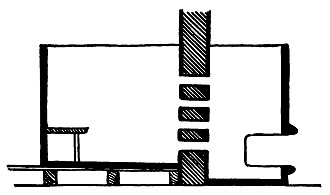 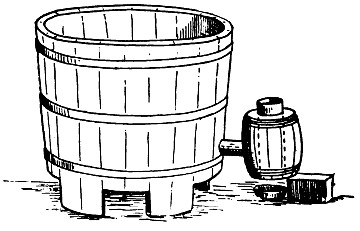
182.
BATH-TUB IN SECTION,
183. BATH-TUB, WITH OUTSIDE
WITH OVEN OUTSIDE THE ROOM HEATING-CHAMBER There are many forms of bathing-tubs, all of them being large and deep. Means for applying the heat direct, which is of course the most economical, is attained in various ways. In the common form (fig. 180), a small chamber of copper is introduced at one end near the bottom of the tub, the mouth having a frame of stone, or of clay or plaster. In this chamber a fire is built, and the water can be brought, if necessary, to the boiling-point. Within the tub a few transverse bars prevent the bather from coming in contact with the hot chamber in which the fire is burning. In another form, a copper funnel or tube passes directly through the bottom of the bathing-tub (fig. 181). The bottom of this tube has a grating of wire; charcoal is then placed in the tube, and its combustion rapidly heats the water. A pan is placed below the tube to catch the coal and ashes that fall through. In a more elaborate form (fig. 182), the bath-tub is in two sections, separated by the partition of the room. These two sections are connected by a number of bamboo tubes or flues, so that the water may circulate freely. The section outside contains the fire-box, in which the fire is built; by this arrangement the bather escapes the discomfort of the smoke from the fire. A very excellent form of bathing-tub is shown in fig. 183, in which, outside the tub, is a chamber not unlike a small wooden barrel closed at both ends; through this barrel runs a copper tube, in which a fire of charcoal is built. The barrel is connected with the bath-tub by a large bamboo tube, having a little square door within, which the bather may close if the water becomes too hot. In many cases a hood is arranged in such a way that the smoke from the fire is carried off. These tubs stand on a large wooden floor, the planks of which incline to a central gutter. Here the bather scrubs himself with a separate bucket of water, after having literally parboiled himself in water the temperature of which is so great that it is impossible for a foreigner to endure it. 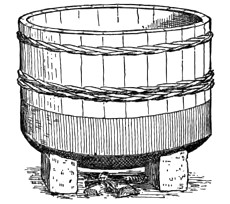 184. BATH-TUB, WITH IRON BASE A very common form of bath in the country consists of a large and shallow iron kettle, upon the top of which is secured a wooden extension, so as to give sufficient depth to the water within (fig. 184). The fire is built beneath the kettle, the bather having a rack of wood which he sinks beneath him, and upon which he stands to protect his feet from burning. This tub is called a Goyemon buro, named after Ishikawa Goyemon, a famous robber of Taiko's time, who was treated to a bath in boiling oil. There are doubtless other forms of bath-tubs with conveniences for heating the water, but the forms here given comprise the principal kinds. There is no reason why similar conveniences might not be adopted in our country in cases where aqueducts or city supply is not available. There are many forms of foot-tubs and large wooden tubs with high backs, in which hot water is poured; but there is no necessity of describing them here.
While in a Japanese house, as we have seen, the most ample conveniences exist for taking a hot or cold bath, the minor conveniences for washing the face and hands are not always so apparent. In such attempts one is more often reminded of a primitive country house at home, where one either goes down to the kitchen, and amid a clutter of pails and pans manages to wash himself, or else takes a tin basin and goes out to the well, and this on a fresh cool morning is by far the more agreeable. In the country a Japanese may be seen in the yard or by the roadside washing his face in a bucket or shallow tub; and at inns, and even in private houses, one is given a copper basin, and a bucket of water being brought he uses a portion of the verandah as a wash-stand. That conveniences for this purpose do exist to some extent may be seen from the accompanying sketches. The one shown in fig. 185 may sometimes be found in country inns at the north. This consists of a shallow trough resting on the floor at the end of the verandah or passage-way. In the trough is a stout water-bucket with cover, and a copper wash-basin. 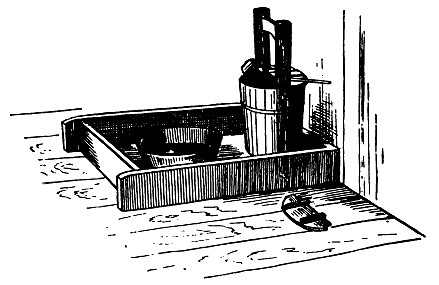 185. LAVATORY IN COUNTRY INN The convenience shown in fig. 186 was in a private house in Tokio. Here the trough was above the level of the floor, in a recessed portion of a passage-way which ran behind a suite of rooms. The wood-work about it was made with great care. The sliding window-frames, covered with stout white paper, admitted sufficient light; while the rich brown pottery-jar, the clean wooden dipper, copper basin, and quaint towel-rack were all attractive features from their very neatness and simplicity. It may seem odd for one to get enthusiastic over so simple an affair as a trough and a few honest contrivances for washing the hands and face; nevertheless such a plain and sensible arrangement is a relief, in contrast to certain guest-chambers at home, where one wishing to go through the rather vigorous performance of dashing into the water with his elbows outstretched, finds these free movements curtailed to the last degree by a regiment of senseless toilet articles in the shape of attenuated bottles, mugs, soap-dishes with rattling covers, and diminutive top-heavy pitchers crowded about his wash-basin, and all resting on a slab of white marble. Things are inevitably broken if they are brought down too hard upon such a bottom. After such recollections, one admires the Japanese sink, with its durable flat-bottomed basin, capacious pottery-jar for water, and ample space to thrash about in without fear of spattering the wall-paper or smashing a lot of useless toilet articles in the act. 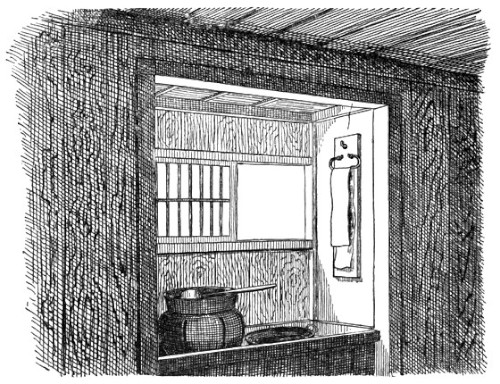 186. LAVATORY IN PRIVATE HOUSE The form last described is the usual one seen in private houses. Conveniences of this nature that are brought to the level of the floor, while giving the Japanese who are used to them no trouble, are found to be exceedingly awkward for a foreigner, who is obliged to go through his toilet in a stooping posture. Often the toilet places are rendered exceedingly attractive by the ornamental wood-work used in their construction. 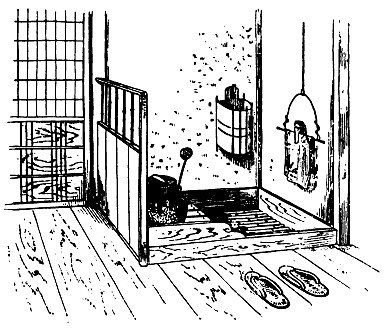 187. LAVATORY COPIED FROM JAPANESE BOOK Fig. 187 is a drawing from a design in a Japanese book, entitled "Yaye Gaki no Den." I have modified the drawing to conform more to our methods of. perspective. This was placed at the end of the verandah, and on a level with the floor. A low partition formed a screen at one side; within the recess thus made was a low shelf for the pottery water-jar. The floor of the sink consisted of bamboo rods placed close together, through which the spilled water found its way by proper channels to the ground without. A paper-lantern hung against the wall, and dipper and towel-rack were conveniently at hand. Other forms might be given, but enough has been shown to illustrate how well these conveniences are arranged for that important daily operation of washing the face and hands. Further conveniences for simply washing the hands are offered in the chōdzu-bachi, description and figures of which will be given under that head.
The towel-rack merits some attention from its exceedingly simple structure. There are many forms, most of them rustic in design and made to be suspended. The following figures (figs. 188-192) illustrate some of the forms in common use. The simplest kind is in the shape of a ring of bamboo suspended by a larger bamboo, to the end of which it is attached. 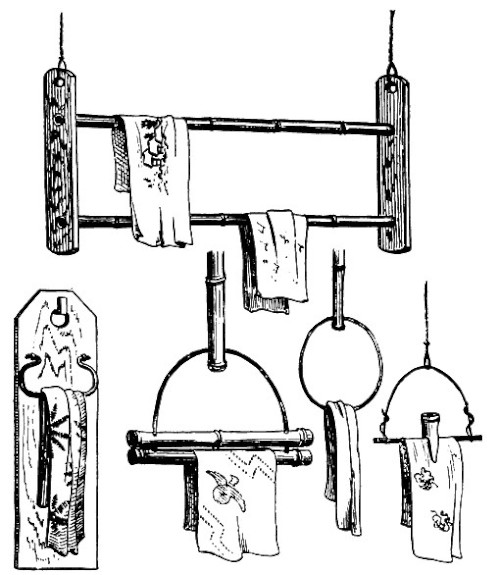 188-192. FORMS OF TOWEL-RACKS Another form, and a very common one, is a yoke of bamboo, the lower ends of which are firmly secured to a larger bamboo, confining at the same time a piece of bamboo which slides freely up and down on the yoke, and by its own weight resting on the towel which may be thrown across the lower bamboo. Another form consists of a loop of bamboo suspended to the side of a board which is hung against the wall. The towels are pretty objects, being of cotton or linen, and usually have printed upon them sketchy designs in two shades of blue.
After living in Japan for a time one realizes how few are the essentials necessary for personal comfort. He further realizes that his personal comfort is enhanced by the absence of many things deemed indispensable at home. In regard to the bed and its arrangements, the Japanese have reduced this affair to its simplest expression. The whole floor, the whole house indeed, is a bed, and one can fling himself down on the soft mats, in the draught or out of it, upstairs or down, and find a smooth, firm, and level surface upon which to sleep, no creaking springs, hard bunches or awkward hollows awaiting him, but a bed-surface as wide as the room itself, and comfortable to the last degree. To be more explicit, the bed is made upon the mats; there is no bedstead, or frame, or circumscribed area of any kind upon or within which the bed is placed.3 The bed-clothes consisting of lightly or heavily wadded comforters are spread upon the floor, one or more forming the bed, and another one acting as a covering. The common ones are wadded with cotton; the best ones are made of silk, and are stuffed with floss silk. In private houses one often gets a bed consisting of a number of these silk comforters, and a most delightful bed they make. In summer the foreigner finds these wadded affairs altogether too hot and stuffy; and at all times he misses the clean sheets which at home intervene between the bed-clothes and his person, though a clean night-dress is provided if desired, and this answers as a substitute for the sheets. In the day-time these comforters are folded up and stowed away in some closet. The usual form of pillow, or makura, consists of a light closed wooden box, with a bottom either flat or slightly convex. On the top of this box is secured a small cylindrically-shaped cushion stuffed with buckwheat hulls. This cushion is tied to the box, and the same string that holds it in place also secures the pillow-case, which is simply a sheet of soft paper folded several times, as shown in the figures here given (fig. 193). 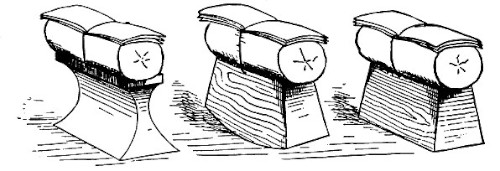 193. FORMS OF PILLOW IN COMMON USE There are many other forms of pillow, either in the shape of a hard cushion or of a square oblong box, the ends being of wood, and the rest of basket-work. Porcelain pillows are also seen, but rarely. There are also many forms of portable ones, some of which fold and stow away in small compass, and others of which are in the shape of a box, within which are drawers and spaces for paper-lantern, matches, mirror, comb, and various articles of the toilet. These are generally used by travellers. The Japanese, with a pillow of this kind, can literally take up his bed and walk; for if he has a head-rest or pillow containing these conveniences, he can get along very well. Pillows in all cases are arranged to support the head naturally, when the shoulder rests on the floor, as in the following figure (fig. 194). To a foreigner, until he becomes accustomed to it, the Japanese pillow seems exceedingly awkward, and his first experience with it results in a stiff neck the next morning; and at intervals during the night he has the sensation that he is falling out of bed, for any freedom of movement of the head results in its downfall from the pillow. Getting used to it, however, one recognizes that this pillow has its good points; the neck is kept free for the air to circulate beneath, and the head is kept cool. This peculiar form of pillow was a necessity for the Japanese so long as the hair was done up in the rigid queue, and is still a necessity for women with their methods of hair-dressing; but with the general abandonment of the queue on the part of the men, a few of them are resorting to head-rests more like our pillows, though much smaller and harder, and on the whole I believe many find this substitute more comfortable. 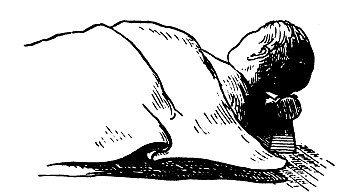 194. SHOWING POSITION OF HEAD IN RESTING ON PILLOW This simple form of bed entails much less work on the chamber-maid than do our arrangements. In a large inn one girl will do the chamber-work for the entire house. In fact this work is ridiculously simple. The futons, or comforters, are rapidly folded up and stowed away, or hung over the balcony rail to air. She gathers up a huge pile of the light pillow boxes in her arms, and carries them to the room below; here she unties the strings which hold the cushions in place, substitutes clean sheets of folded paper for the soiled ones, and the work of bed-making is done. With a duster, consisting of strips of tough paper tied to the end of a slender bamboo, the rooms are dusted and made ready for the next arrivals. As matters pertaining to the toilet are performed in other portions of the house, the rooms are placed in order in an incredibly short time. In a crowded inn each guest may occupy the dimensions of one mat; and the entire floor is occupied in this way. In winter a thickly-wadded comforter is provided, which is made in the form of a huge garment having capacious sleeves. Many rooms have a square hole in the floor in which, when needed, a fire of charcoal may be kindled; this is called a ro. Above the ro a square frame of wood is adjusted, and the bed-clothes being placed over this frame are thoroughly heated, so that one may go to bed in the warmest of nests. In the day-time one may gather a portion of the bed-clothes about him, and keep warm by the little coal-fire burning beneath. Fig. 195 is an illustration of this opening in the floor, with frame-work above to keep the bedclothes from falling on the fire below. A little wooden box is used for the purpose of holding an earthen receptacle for coals, and this is taken to bed as a substitute for the hot stone or brick which is often used at home for a similar purpose. From the inflammable nature of the bedding, many fires must originate from carelessness in the use of this luxury. 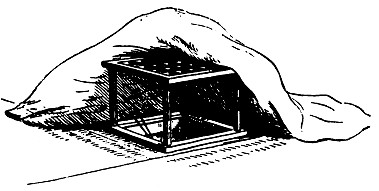 195. HEATING ARRANGEMENT IN FLOOR In this connection it may be well to add that oftentimes little square thin cushions are provided for guests to sit upon; and one often sees a light round cushion which is used as an elbow-rest when one is reclining (fig. 196). 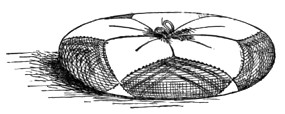 196. ELBOW-REST Mosquito nettings, or kaya, are to be found in all houses, even the poorest people being supplied with them. The usual form of netting is made in the shape of a square box, nearly as large as the room; and this, when placed in position, is suspended at the four corners by cords which are tied to pegs in the four corners of the room. A smaller netting for infants is made on a framework of bamboo like a cage, and this may be placed over the infant wherever it may drop to sleep on the mats.
An inseparable accompaniment of every Japanese home, from the most exalted to the very humblest, is the hibachi. This object consists of a vessel partially filled with fine ashes, containing when in use a few bits of burning charcoal. This vessel may be of bronze, iron, porcelain, earthenware, or even of wood lined with copper, or a wooden box containing an earthen vessel. The most usual form of hibachi consists of a square wooden box lined with copper, between which and the wood is a layer of clay or plaster (fig. 200). A very cheap and common form is a wooden box in which is a cylindrical jar of black unglazed earthenware (fig. 197). A pair of iron rods generally held together at one end by a large ring answer as tongs, being used after the manner of chop-sticks. These are either stuck in the ashes, or when the wooden box contains the fire-vessel separately there may be secured in the corner of this box a bamboo tube in which the tongs are kept. 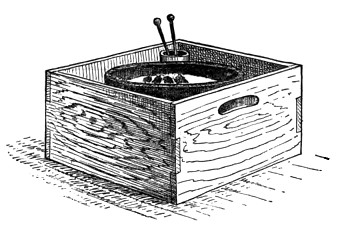 197. COMMON HIBACHI In bronze hibachi there are handles or rings on the sides for convenience of moving. In the square box hibachi cleats are nailed on opposite sides to answer as handles; or, as is more usually the case, narrow holes are cut through the sides of the box to accommodate the fingers, as shown in the previous figure (197). Much art and skill are displayed in the bronze and iron hibachi, and forms such as might be found in an ordinary house in Japan would be regarded as gems in collections of bric-ΰ-brac at home. Even the wooden hibachi are often objects of exquisite taste. We recall an old one made of the richest grained wood, in which were drawers at one end to hold pipes and tobacco, and around the base of the box ran a deep band of black lacquer inlaid with ornaments of pearl, the design representing in various positions the iron bits of a horse. So various and oftentimes inexplicable are the surprises in their designs, that one might almost imagine the decorator to have opened while blindfolded a dictionary of objects, and to have taken the first word he saw as the theme for his subject. 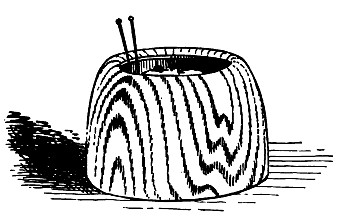 198. HIBACHI A very favorite form of wooden hibachi is shown in fig. 198. This consists of a single piece of oak or other hard wood turned in a cylindrical form, the grain being brought into relief by special treatment, and the inside lined with copper. An old one richly colored and polished by age is much esteemed. The hibachi may be quite a large affair, and subserve the duties of a stove as well. An iron ring having three legs, or a grid spanning the box, is provided on which the tea kettle is supported, or even fishes broiled. The hibachi is a sort of portable fireplace, around which the family gather to gossip, drink tea, or warm their hands. The one represented in fig. 199 shows a little child warming itself, while wrapped in a thick night-garment. One will often observe a Japanese absent-mindedly stirring the coals or ashes with the tongs, just as we are fond of doing at home. 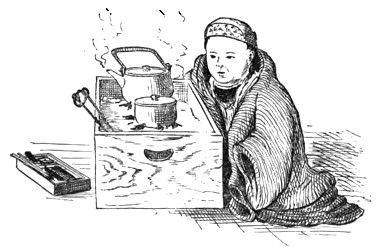 199. HIBACHI A sentiment prompts many families to keep the hibachi fire burning continually; and I was told that in one family in Tokio the fire had been kept alive continuously for over two hundred years. In a winter party the hibachi are previously arranged by the servants, one being allotted to each guest; and the place where each is to sit on the matted floor is often indicated by a little square cloth-cushion. Fig. 200 illustrates the arrangement of hibachi for company. 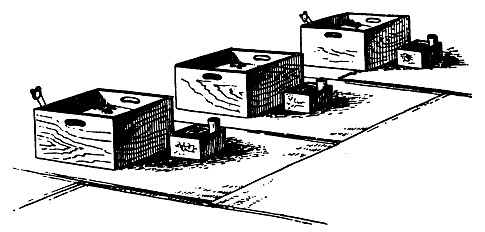 200. HIBACHI ARRANGED FOR COMPANY Whenever you call on a friend, winter or summer, his very first act of hospitality is to place the hibachi before you. Even in shops the hibachi is present, or is brought in and placed on the mats when a visitor enters. A smaller form of hibachi, called a tabako-bon (fig. 201), is also usually brought to a visitor. It is a convenience used by smokers, and is commonly in the form of a square wooden box containing a small earthen vessel for holding hot coals, and a segment of bamboo either with or without a cover. This last is a hand cuspidore, and great refinement is shown in using it, either by averting the head or screening the mouth with the hand. The cuspidore, or spittoon, as commonly used by us, seems vulgar in comparison with that of the Japanese. Sometimes the tabako-bon is made out of the burl of an oak in which a natural depression occurs (fig. 202). This form is often seen in Japanese picture-books. Another form is shown in fig. 203. There are many and various designs for this convenience, some of them being very odd. To replenish the hibachi with hot coals there is provided a shallow iron bowl called a dai-ju-no (fig. 204). Upon the bottom of this bowl is riveted a bent strip of iron, which in turn is secured to a stand of wood. The bowl has an iron socket, into which is fitted a wooden handle. In this vessel burning coals are brought by the servant. 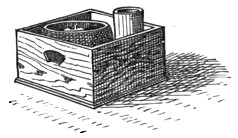 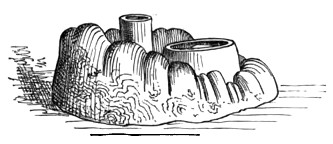 201. TABAKO-BON 202. TABAKO-BON 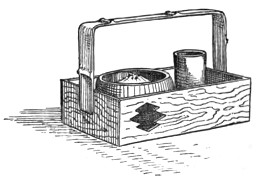 203. TABAKO-BON When the hibachi is properly arranged, it is customary to heap the ashes in a pyramidal pile about the coals and mark a series of radiating lines upon it. The charcoal to replenish the fire is generally kept in a basket, though sometimes a deep wooden box with a handle is used. The baskets used for this purpose are always tasty affairs, having often a rich brown color from age. In the basket is a pair of old brass or copper rods with which to handle the coal. A single stick of coal buried vertically in the ashes is burned for several hours. The charcoal-vender has a curious way of utilizing the small and pulverized fragments of the charcoal, by mixing the powder with some kind of sea-weed, and then forming the mass into round balls the size of a large orange. In making these balls he goes through a motion precisely like that seen in making snow-balls. These are afterwards dried in the sun, and seem to burn very well. In riding along the streets one often sees trays filled with these black balls exposed to the sun.
Before kerosene oil was introduced into Japan the means of illumination were of the most meagre description. One can hardly realize the difficulty a student must have experienced in studying his Chinese Classics by the feeble light emitted from tiny wicks, or the dim and unsteady flame of a vegetable-wax candle, a light rendered all the more feeble when filtered through a paper lantern. It is related that in former times devout students of the Chinese Classics were accustomed at night to read a single character at a time by the dim illumination of a glowing coal at the end of an incense-stick held close to the page! of the many things which the Japanese have adopted and promptly utilized from Western nations, I know of nothing which has been so great a boon to all the people as kerosene oil. The Western practice of medicine is rapidly displacing the empirical Chinese practice, and this when accomplished will be, beyond all question, the greatest boon. There are many outlying districts, however, as well as thousands of inhabitants of the cities, still under the sway of Chinese methods, and the beneficent effects of the rational treatment of disease has not yet been widely felt; but everywhere throughout the Empire the bright light of kerosene has lengthened the day for all. 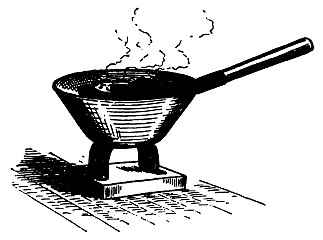 204. PAN FOR HOLDING BURNING CHARCOAL Japanese candles are made of a vegetable wax, having a wick consisting of a roll of paper, not unlike the ordinary paper lamp-lighter. This wick, being hollow, is fitted to a sharp spur of iron about an inch long, in the candlestick (in England the pricket candlestick went out of use a few centuries ago; in Japan it is still retained). At the top of the candle the wick projects in a firm, hard point. When a candle has burned low, it is removed from the candlestick and placed on the end of the new candle, which is then adjusted on the sharp spur. By this simple device all the candle is utilized in combustion. A superior kind of candle, made in the province of Aidsu, is beautifully painted in bright colors, with designs of flowers and other ornamental subjects. Candles are depended upon to illuminate the rooms, as well as to light the hand-lanterns which are carried about the streets, and those which are used for the house, these last consisting of a square or hexagonal frame, covered with paper and attached to the end of a short handle. A common form of Japanese candlestick, called te-shoku, is represented in fig. 205. It is a rude affair made of iron, supported on three legs, and has a wide disk to prevent the melted wax from dropping on the mats, and a ring about the candle to prevent its falling over. It is easily picked up from the floor by its longer arm. 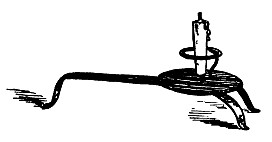 205. IRON CANDLESTICK Another common form of candlestick consists of a hemispherical base of brass, ten or fifteen inches in diameter, from which a rod of the same metal runs up to the height of two feet or more, on the end of which is the usual cup and spur. Candlesticks of this description are seen in fig. 177 (page 196). The snuffer is usually in the form of a blunt pair of tweezers, with which the burnt wick is removed; the servants, however, often take the hibachi, or tongs, and, removing the wick, thrust it into the ashes of the hibachi. Candlesticks of rustic design, manufactured of curious woods, are made at Nikko and other famous resorts, more as mementos to carry away than as implements intended for actual use.
The Japanese lamp is usually in the form of a shallow saucer, in which vegetable oil is burned. The wick, consisting of long slender rods of pith, is held down by a little ring of iron, to which a spur is attached for a handle. The unburned portion of the wick projects beyond the saucer, and as it burns away at one end is moved along. The saucer rests in a disk or ring of iron, which is suspended within a frame covered with paper. A common form of this lamp, or andon, is shown in fig. 206. It consists of a square frame of wood covered with paper, open above and below, and having one side in the shape of a movable lid, which can be raised when the lamp needs tending. This frame is secured to two uprights, which spring from a wooden stand in which may be a drawer containing extra wicks and a pair of snuffers. These uprights extend above the lantern, and have a cross-piece by which the lantern is lifted, and another cross-bar just below from which the lamp hangs. The light from this night-lamp is feeble and uncertain, and by it one can barely see his way about the room. 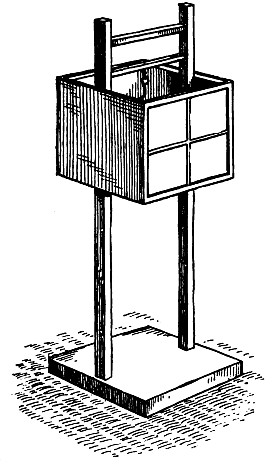 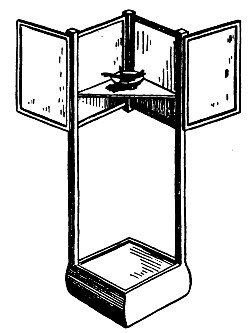 206. LAMP 207. LAMP There are many kinds of andon, some being very ingenious. One form is cylindrical, being composed of two frames, one within the other, the outer frame revolving in a groove in the stand. One half of each lantern is covered with paper, so that by turning the outer frame the openings are brought together, and thus access is gained to the lamp. Another form of andon (fig. 207) opens in a different way, with a little shelf in one corner to hold the saucer of oil. 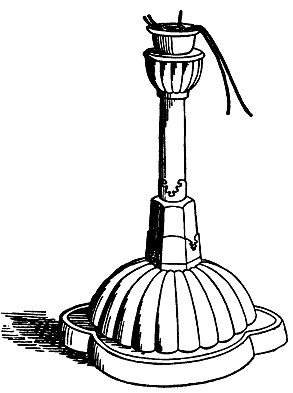 208. LAMP AND LACQUERED STAND. (COPIED FROM A JAPANESE WORK.) Still another form (fig. 208) is copied from an old colored picture-book; this consists of an elaborate lacquered stand mounted in metal, with a lamp supported on the top. In the passage-ways, and at the head of stairways, lamps are often fixed to the wall. In Osaka I saw a curious one, which is represented in fig. 209. The frame was hung by hinges to a board which was affixed to the wall (the hinges being above), and rested against the board like a cover, and was lifted up when the lamp needed attention. In an andon in Osaka, I saw a good bit of iron-work (fig. 210) made to suspend the lamp. 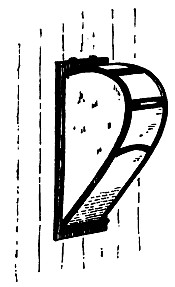 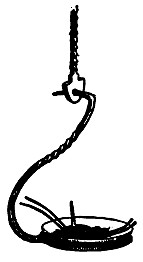 209. WALL-LAMP 210. LAMP Lamps made of pottery are rarely seen. Fig. 211 is a sketch of an old lamp of Oribe ware from the author's collection. An inclined portion within supports the wick, and the cover is notched in front and behind to allow the passage of the wick. Another form from the same collection, made in the province of Iga, is shown in fig. 212. In this lamp the wick must have been made from some fibre; a hole in the wick-tube is seen through which the wick can be moved along. The handle of the lamp has a slot in it, so that it may be hung against the wall. It is possible that these two lamps, or at least the last one, are for the kami-dana, a shelf which supports the household shrine. 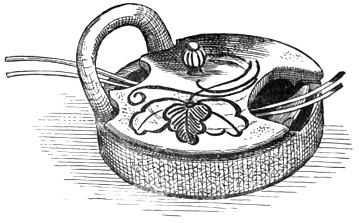 211. POTTERY LAMP In connection with lamps made of pottery, it may be well to add that now and then one meets with a pottery candlestick. That shown in fig. 213 represents one from the author's collection, made of Owari pottery. Near the chōdzu-bachi, hanging from the edge of the verandah roof above, is usually seen an iron lantern, generally a quaint old rusty affair suspended by a chain, and, when lighted, admitting through the perforations in its side the faintest possible glimmer. In figs. 240 and 253 (pages 255 and 267) lanterns of this description may be seen. 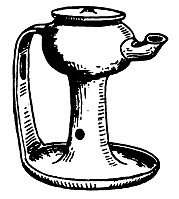  212. POTTERY LAMP 213. POTTERY CANDLESTICK Street-lanterns are often affixed to short slender posts at the gateway or doorway of a dwelling. The usual form of this frame and lantern is represented in fig. 214. It is not over five feet in height, and seems to be a frail affair to expose on a public street. The very frailty and lightness of such objects, however, often exposed as they are with entire safety on busy thoroughfares, are striking indications of the gentle manners of the Japanese. One is led to wonder how long such a delicate street-lamp would remain intact in our streets, with those mobs thronging by that seem to be solely a product of our civilization. These, and a thousand similar points of contrast, set a thoughtful man reflecting on the manners and customs of the two great civilizations.
In nearly every house one sees perched up on a shelf called the kami-dana a curious little architectural affair, which on more special examination proves to he a model of a Shin-to shrine, or a principal feature of a Shin-to altar, a circular mirror. On the shelf in front of this are a few lamps (or a single lamp) and trays, containing at times food-offerings. If the shrine is in the shape of a box, then accompanying it are various little brass stands, slips of wood with characters written upon them, and in short a miniature representation, apparently, of the paraphernalia used in a large temple. The shelf is high up on the wall near the ceiling; and in old houses this region is black with the accumulations of smoke from the little lamp which is lighted every night, and which may have burned there for a century. These are the Shin-to shrines. 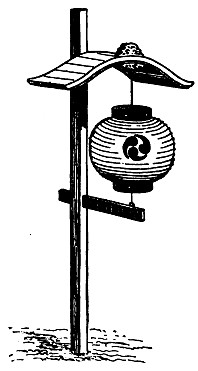 214. FIXED STREET-LANTERN The Buddhist household shrines, having a figure of Buddha or of one of his disciples, or perhaps of some other god, are much more ornate, and rest on the floor, at least so I was informed. My informant also told me that the majority of the people worship at the shrines of both great beliefs, and that all Buddhists, unless very strict, have Shinto shrines in their houses. Indeed, Buddhists and even Buddhist priests have been known to go into the Roman Catholic cathedral at Osaka, and bow in reverence before the altar and other emblems of an alien religion. The tolerance and charity evinced in such acts is something pathetic, when one recalls the mutually hostile attitude of the two great branches of the Christian Church! Flowers and incense-burning usually accompany the Buddhist household shrine, while before Shin-to shrines incense is not burned. Buddhist shrines have placed before them lamps of brass, or hanging lamps, while in front of the Shin-to shrine candles of vegetable wax are burned. In unglazed, hand-made pottery called kawarake oil is burned, which is also used for food-offerings. For offerings of wine, oval bottles of peculiar shape, with long narrow necks, are used; these are called miki dokkuri, miki being the name of the wine offered to the gods, and tokkuri the name of a sake bottle. In front of these shrines one may often see the inmates of the house bow their heads, clap their hands, and then, rubbing the palms together in an imploring gesture, pray with much earnestness. So far as I have observed, every house has this domestic altar. In shops, too, one often sees the shrine; and in the larger and more wealthy shops the shrine is often a very expensive affair. In a famous silk-shop in Tokio is a large model of a Shin-to temple suspended by iron rods from the beams above. In front of it hang two big metal lanterns. It struck me that this display of piety was rather ostentatious, and paralleled similar displays sometimes seen at home; in this supposition, however, I may be doing an injustice. Among the intelligent classes the household shrine seems to be provided for the female members of the family only, the men having outgrown these superstitions; and it was interesting to observe that in Japan, as elsewhere, the women being as a rule less informed made up the majority of those attending public worship. 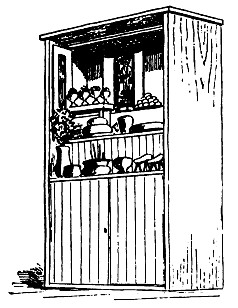 215. HOUSEHOLD SHRINE The sketch here given of a Buddhist household shrine (fig. 215) was seen in a house of the most squalid character. The various vessels were filled with boiled rice, with loaves of mochi made of a special kind of rice, and a number of unripe peaches on the lower shelf, in the right-hand corner, are seen a sweet potato and a radish propped up on four legs, looking like toy deer or beasts of some kind. Whether this indicated the work of children or represented the horses upon which the gods could take a ride, was not ascertained.
A household shrine to which the children pay voluntary and natural devotion are the birds' nests built within the house. It is a common thing, not only in the country but in large cities like Tokio, for a species of swallow, hardly to be distinguished from the European species, to build its nest in the house, not in an out-of-the-way place, but in the room where the family may be most actively engaged, or in the shop fronting the street, with all its busy traffic going on. The very common occurrence of these birds' nests in houses is another of the many evidences of the gentle ways of this people, and of the kindness shown by them to animals. 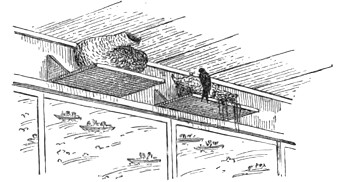 216. SWALLOWS' NESTS IN PRIVATE HOUSE When a bird builds its nest in the house, a little shelf is promptly secured beneath it, so that the mats below shall not be soiled. The presence of the bird in the house is regarded as a good omen, and the children take great pleasure in watching the construction of the nest and the final rearing of the young birds. I noticed that many of the nests built within the house were much more elaborately made than those built in more exposed positions. From the symmetrical way in which many of these were constructed, one might almost imagine the birds had become imbued with some of the art instincts of the people. Fig. 216 illustrates the appearance of a group of these birds' nests in a house.
It would be an affectation of false delicacy were no allusion to be made to the privy, which in the Japanese house often receives a share of the artistic workman's attention. From its position in the house, and especially in the public house, it is often a source of great discomfort. In the better class of private houses in Japan, however, there are less annoyance and infinitely less danger from this source than are experienced in many houses of the wealthy in our great cities. In the country the privy is usually a little box-like affair removed from the house, the entrance closed half way up by a swinging door. In the city house of the better class it is at one corner of the house, usually at the end of the verandah, and sometimes there are two at diagonal corners, as a reference to the plans will show. A curious superstition among many is attached to the position of the privy in its relation to the house, a trace possibly of the Chinese Fung shui. The privy generally has two compartments, the first one having a wooden or porcelain urinal; the latter form being called asagaowa, as it is supposed, to resemble the flower of the morning glory, the word literally meaning "morning face" (fig. 219). The wooden ones are often filled with branches of spruce, which are frequently replenished. The inner compartment has a rectangular opening cut in the floor, and in the better class of privies this is provided with a cover having a long wooden handle. The wood-work about this opening is sometimes lacquered. Straw sandals or wooden clogs are often provided to be worn in this place. 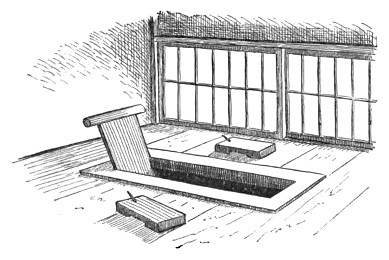 217. INTERIOR OF PRIVY The interior of these apartments is usually simple, though sometimes presenting marvels of cabinet-work. Much skill and taste are often displayed in the approaches and exterior finish of these places. 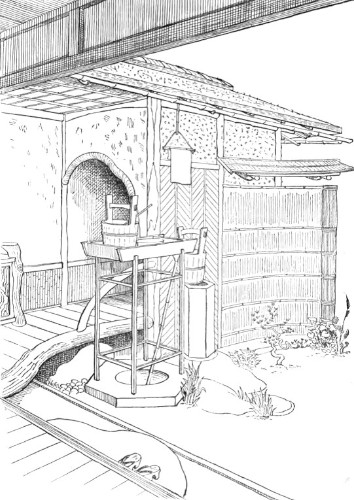 218. PRIVY OF INN IN HACHI-ISHI VILLAGE, NIKKO Fig. 217 shows the interior of a common form of privy. Fig. 218 illustrates the appearance of one in an inn at Hachi-ishi, near Nikko. The planking in the front of the sketch shows the verandah; from this, at right angles, runs a narrow platform, having for its border the natural trunk of a tree; the corner of a little cupboard is seen at the left; the ceiling is composed of matting made of thin strips of wood, and below is a dado of bamboo. The opening to the first apartment is framed by a twisted grape-vine, while other sticks in their natural condition make up the frame-work. Beyond the arched opening is another one closed by a swinging door; and this is usually the only place in the house where one finds a hinged door, except, perhaps, on the tall closet under the kitchen stairs. The roof is covered thickly with the diminutive shingles already alluded to. Outside a little screen fence is built, a few plants neatly trained below, and a typical privy of the better class is shown. The wooden trough standing on four legs and holding a bucket of water and a washbasin is evidently an addition for the convenience of foreign guests. The chōdzu-bachi with towel rack suspended above, as already described, is the universal accompaniment of this place.  219. PRIVY CONNECTED WITH A MERCHANT'S HOUSE IN ASAKUSA As one studies this sketch, made at an inn in a country village, let him in all justice recall similar conveniences in many of the country villages of Christendom! In Fig. 219 is shown the privy of a merchant in Asakusa, Tokio. The door was a beautiful example of cabinet-work, with designs inlaid with wood of different colors. The interior of this place (fig. 220) was also beautifully finished and scrupulously clean. 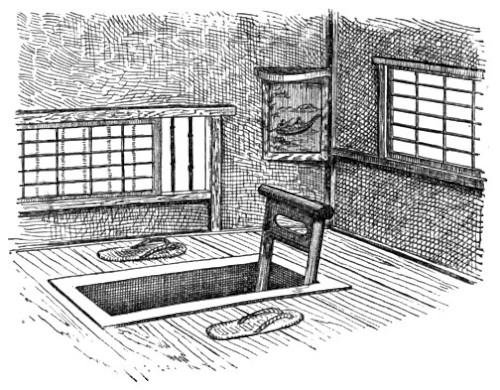 220. INTERIOR OF A PRIVY IN ASAKUSA The receptacle in the privy consists of a half of an oil barrel, or a large earthen vessel, sunk in the ground, with convenient access to it from the outside. This is emptied every few days by men who have their regular routes; and as an illustration of the value of this material for agricultural purposes, I was told that in Hiroshima in the renting of the poorer tenement houses, if three persons occupied a room together the sewage paid the rent of one, and if five occupied the same room no rent was charged! Indeed, the immense value and importance of this material is so great to the Japanese farmer, who depends entirely upon it for the enrichment of his soil, that in the country personal conveniences for travellers are always arranged by the side of the road, in the shape of buckets or half-barrels sunk in the ground. Judging by our standards of modesty in regard to these matters there would appear to be no evidence of delicacy among the Japanese respecting them; or, to be more just, perhaps I should say that there is among them no affectation of false modesty, a feeling which seems to have developed among the English-speaking people more exclusively, and among some of them to such ridiculous heights of absurdity as often to be fraught with grave consequences. But among the Japanese it would seem as if the publicity given by them to the collecting of this important fertilizer had dulled all sensitiveness on their part, if it ever existed, concerning this matter.4 Indeed, privacy in this matter would be impossible when it is considered that in cities as in Tokio, for example of nearly a million of inhabitants this material is carried off daily to the farms outside, the vessels in which it is conveyed being long cylindrical buckets borne by men and horses. If sensitive persons are offended by these conditions, they must admit that the secret of sewage disposal has been effectually solved by the Japanese for centuries, so that nothing goes to waste. And of equal importance, too, is it that of that class of diseases which scourge our communities as a result of our ineffectual efforts in disposing, of. sewage, the Japanese happily know but little. In that country there are no deep vaults with long accumulations contaminating the ground, or underground pipes conducting sewage to shallow bays and inlets, there to fester and vitiate the air and spread sickness and death. On the other hand it must be admitted that their water supply is very seriously affected by this sewage being washed into rivers and wells from the rice-fields where it is deposited; and the scourge of cholera, which almost yearly spreads its desolating shadow over many of their southern towns, is due to the almost universal cultivation of the land by irrigation methods; and the consequent distribution of sewage through these surface avenues renders it impossible to protect the water supply from contamination. ________________ 1 A correspondent in the "Pall Mall Gazette," in protesting against the attempt to impose European clothing on those people who are accustomed to go without any, says: "In many parts of India there is a profound suspicion of the irreligiousness of clothing. The fakir is distressed even by the regulation rag upon which the Government modestly insists, and a fully dressed fakir would be scouted. The late Brahmo minister, Chesub Chunder Sen, expressed the belief that India would never accept a Christ in hat and boots. The missionary should remember that clothes-morality is climatic, and that if a certain degree of covering of the body has gradually become in the Northwest associated with morality and piety, the traditions of tropical countries may have equally connected elaborate dress rather with the sensualities of Solomon in his glory than with the purity of the lily as clothed by Nature." 2 Rein says: "The cleanliness of the Japanese is one of his most commendable qualities. It is apparent in his body, in his house, in his workshop, and no less in the great carefulness and exemplary exactness with which he looks after his fields." 3 From the name tokonoma, which means "bed-place," literally "bed of floor," it is supposed that in ancient times the bed was made or placed in this recess. 4 In this connection it may be interesting to mention the various names applied to the privy by the Japanese, with a free translation of the same as given me by Mr. A. S. Mihara: Setsu-in, "snow-hide;" Chodzu-ba, "place to wash hands" (the chōdzu-bachi, a convenience for washing the hands, being always near the privy); Benjo and Yo-ba, "place for business ;" Ko-ka, "back-frame." Habakari is a very common name for this place; the word Yen-riyo, though not applied to this place, has the same meaning, it implies reserve. These words with their meanings certainly indicate a great degree of refinement and delicacy in the terms applied to the privy. |